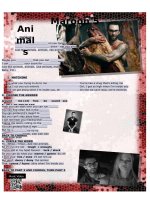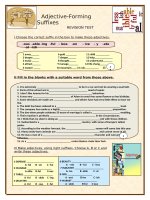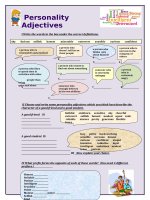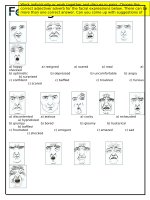islcollective worksheets intermediate b1 upperintermediate b2 advanced c1 adults high school listening reading speaking 479234976574f3202603a85 42246167
Bạn đang xem bản rút gọn của tài liệu. Xem và tải ngay bản đầy đủ của tài liệu tại đây (74.61 KB, 3 trang )
ESL with Florina : />
From: />Driving challenges
I’ve been driving for 40 years which sounds a lot longer than it actually feels. I’ve
seen a lot of interesting driving scenarios during that time; people making turns
from the wrong lane, cars driving the wrong way on a one way street, people
moving across 4 lanes of traffic to make an exit, others who stopped on an
entrance ramp, deer crossing a highway, people drifting into my lane, and much
more. It continues to amaze me how fast a driving situation can change and how
equally fast I’ve had to respond to what’s happening around me.
Teens, who are learning how to drive, don’t have the experience to know what to
do in these situations. A study, conducted by the Foundation for Advancing
Alcohol Responsibility, found that 67% of teen drivers, didn’t know what to do in
complex driving scenarios. This made me think about the times my sons were
learning to drive and what I would do different given this statistic. It’s impossible
to expose them to every possible driving scenario, but I would want to expose them
to these 5 scenarios.
Left Turns: Left turns can be hard enough for adults let alone teen drivers. It takes
practice to judge how fast an oncoming car is approaching an intersection to safely
make the turn. Have them practice making them as often as possible where you can
walk them through judging speed, distance, as well as what to do when the light
turns red and they are in the intersection. Remind them that oncoming traffic may
still have a green signal before they turn in front of someone.
Dead Traffic Signal: If you live in Dallas, think back to the storm that came
through the area a few weeks ago. Power was out for homes, businesses, and
many traffic signals. When a signal is not working, treat it as a stop sign, even
when it appears safe to go through it. It’s best to stop and confirm it’s safe to
proceed before continuing through the intersection.
Rail Road Crossing: It’s always tempting to beat the train when the warning lights
flash, the bell sounds, and the cross arm starts to drop. Doing so can be deadly
though. The average freight train is between 1 and 2 miles long. If it’s traveling at
50 miles per hour, it can take up to 2 miles to stop once the emergency brake is
applied. If a driver misjudges, the train wins every time.
Highway Driving: There are several things a teen driver can learn when you have
them drive for an hour or two on a trip. The lessons include handling a car or truck
at highway speeds, decision making when coming up behind someone, safely
passing a car going the same direction, moderating speeds, as well as entering and
exiting the freeway. Driving on an interstate highway with 4 or more lanes is very
different than driving on a 2 lane highway. Practice with them on both types of
highways.
Work through how to stay alert by looking down to the speedometer, and rotating
glances to the side and rearview mirrors. Remind them to stop and get out of the
car every 2 hours to avoid fatigue and dozing off at the wheel.
Rush Hour Driving: Take your teen driver out during rush hour traffic on a regular
basis. It’s very different from normal highway driving because of the start and stop
and some of the crazy things other drivers do when changing lanes. If they can
manage rush hour traffic in Dallas, Fort Worth, Houston, Austin, or San Antonio,
with you in the car, they will do much better when they’re driving alone.
Parents, please remember they are practicing which means learning something
new. They will make mistakes, but it’s better to expose them to these driving
scenarios with you along than when they are on their own.
What other scenarios do you think a teen driver needs to be exposed to with you or
their parent in the car?
For teachers: This is a reading and conversation activity. Begin by asking your
students what would be the most difficult driving scenarios? Pre-teach some of the
highlighted vocab and then have them read the text. Check for comprehension by
asking questions such as:
Who is the text addressed to?
What is the text about?
Where is the author from?
Why is X scenario difficult according to the author?
Students can answer orally.
Then ask additional questions?
Are these scenarios difficult only for teens? Explain.
What is the most difficult part about driving to you?
You can also have them identify vocab related to streets/traffic and vocab related
to car parts. If you want, you can also work around a grammar point, such as
present perfect, pres perf continuous, giving instructions, adjectives, gerunds and
so on.









